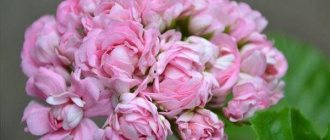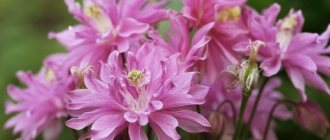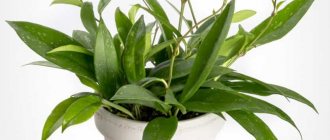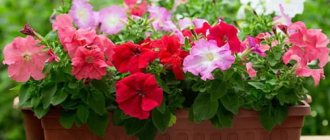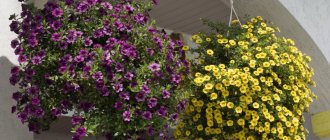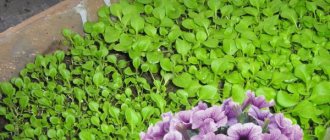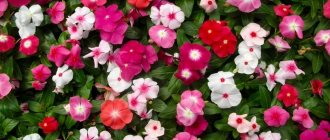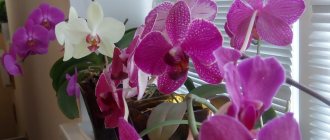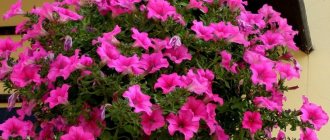How to plant ampelous petunia in a flowerpot
There are several types of petunia; the ampelous petunia differs from others in its stems descending to the ground. Usually it is planted in a hanging pot, so the clusters of buds look more impressive. The plant, despite the noticeable successes of breeders, remains quite capricious to care for. Fortunately, by following simple rules, you can successfully plant a young flower.
Petunia is ideal for decorating a loggia garden
Rules and techniques for planting ampelous petunia in flower pots
Planting ampelous petunia in a flower pot is a step-by-step process; before this, the seedlings are prepared. Planted at the end of February, by the beginning of June it is ready to be transplanted into a pot. A hanging planter must have a tray - petunias love water.
Note! The grown plant will weigh a lot, and with soil even more - the material of the container must be durable.
The pot for petunia should be the right size for it.
Before planting you need to prepare the soil:
If the composition is too dry or the air humidity is low, you can add hydrogel to the soil.
Important! Immediately after planting, it is not recommended to expose the pot with the seedling to the open air on the sunny side. Sowing is done in winter, and planting is done closer to May. The plant must get used to the new place in a calm environment.
Ampel varieties of petunias are distinguished by a variety of colors
You can also purchase a ready-made substrate for growing petunia, choosing the option for a specific variety. Before pouring into the pots, the soil must be disinfected. After placing the seedling in the ground, you need to distribute the soil well; there should be no voids between the roots. You should not press down the soil too much; this will negatively affect the condition of the root system.
What volume of pots is needed for hanging petunia?
In this regard, it is difficult to formulate a general rule; much depends on the plant variety, the number of bushes in the pots and other factors. For small single compositions, a 5-liter pot is sufficient, for larger ones - up to 10 liters.
Note! If two varieties of petunias with voluminous flower heads will grow in one pot, you can consider the option of a wide flowerpot.
How many ampelous petunias should be planted in one flowerpot?
The desire to grow a lush head of buds leads to the obvious question of the number of plants in one pot. There is an opinion that it is wrong to plant more than one, the roots will intertwine, and nothing good will come of it. At the same time, other gardeners claim that there can be 2-3 petunias in one pot. Their roots must be positioned so that they do not intertwine. That is why, through trial and error, successful combinations of different varieties were obtained.
The number of petunias in one pot depends on the variety
The problem is that hanging plants tend to grow, and the lower part of the plants does not receive enough oxygen. In this case, you will have to pinch and shape the petunia, and also monitor the condition of the soil.
Growing and caring for pots
Petunia loves sunlight, warmth and regular watering, and her care is built around this. The soil in the pots should not dry out; it must be watered constantly. Petunia blooms for a long time, it needs enough moisture. But you can’t flood the plant; the roots may begin to rot. In summer, more intensive watering is needed, in winter - moderate.
Important! The soil in the petunia pots should always be moist (not wet).
The plant loves the sun, it needs to be grown on the south side, since constant exposure to the shade will greatly harm it. The optimal temperature during flowering is 23-27 °C. It tolerates minor changes quite easily. During flowering, one should not forget about feeding.
Properly cared for petunia produces a lush head of large buds
Petunia is resistant to diseases and pests, and if infection does occur, it tolerates treatment well. It is important for the grower to quickly detect the problem and take the necessary measures. The better he takes care of her, the less likely it is to become infected.
Important! Fungicides are used to treat diseases.
Dangerous pests for ampelous petunia are aphids, spider mites and slugs. Spraying with a soap solution gives a good effect; the previously diseased plant must be isolated from others.
Bush formation
The first thing you need to know when planting petunia in a pot is that it grows a lot. That is, the shoots create a huge head, leaving the stems bare, and the plant looks unattractive. At the same time, the root system spends all its energy on the foliage, and the buds turn out small and dull. The problem can be solved by pinching - removing unnecessary shoots. You should remove 2/3 of the length; new shoots will grow in place of the previous shoots. This way the head of buds will prevail over the foliage and look harmonious.
With proper pinching, you can get a spectacular composition from different varieties of petunias.
Types of petunias and their place in the garden
Recently, the fashion for petunias, which our grandmothers loved and appreciated, has returned. Once again we admire lush and colorful clouds in graceful hanging planters, garlands cascading and wrapping around gazebos, as well as bright flowers along garden paths. This is a hybrid plant, the varieties of which are usually divided into groups.
Bush hybrid groups
Perennial bush petunia is perfect for flower beds, edgings and borders. Smaller varieties can be grown in containers. The Multiflora subgroup of flowers is distinguished by a large number of medium-sized inflorescences. In the Grandiflora subgroup, flowers can reach 16 cm in diameter (Triumph variety). The most famous series are Fantasy, Dream, Titan, Polaris, Storm, Hit Parade and the early Ultra variety.
The bush petunia Sophistica Blackberry amazes with its unusual colors. Who would have thought that a flower that we have become accustomed to since childhood could look so beautiful?
The formation of bushes occurs independently. If you want to influence the appearance of the plant, it is enough to cut off its top at the level of the third internode, then the flower will begin to branch and become more magnificent.
A group of weather-resistant flowers
The group is called floribunda. This is an average option, which according to its characteristics can be placed between Multiflora and Grandiflora. Mass plantings are often decorated with double floribundas. The most popular varieties are the Celebrity and Sonya series.
Unpretentious but delightful plants that, with proper care, will delight you and those around you with their lush blooms all summer long.
Picturesque flower thickets
Cascading groups can produce shoots that grow in all directions, forming dense flower thickets. This is an excellent decoration for gazebos, verandas and terraces. The remarkably beautiful varieties Typhoon, Rose, Cherry, Ramblin and Silver throw out lashes up to 1.5 meters.
The cascading petunia falls on you like a whole flower waterfall. Imagine your gazebo in such a colorful design, and you will immediately want to realize what you imagined
Living flower curtains
Unlike cascading species, ampelous ones emit shoots that are directed only downward. These varieties of petunias are ideal for hanging planters. However, planted in a flower bed, they form a beautiful flower covering on the ground.
We offer you to watch the video in detail about the varieties and best varieties.
Varieties of ampelous petunias for hanging flower pots
The following varieties are best suited for a hanging flowerpot.
Avalanche
A popular variety that differs from others in its upright young shoots. As they grow, they bend under the weight of the shoots. The buds are large, the scattering turns out to be an avalanche. The color of the petals is varied: from pastel to intense shades.
Velveteen
A Czech variety with a height of 80-100 cm. It is used not for flowerpots, but as a flower garden decoration. The carpet reaches a height of 25 cm and looks amazing for large areas.
For your information! An additional purpose is to create flower trees.
Shock Wave
A suitable variety for unfavorable weather conditions, as it is resistant to cold and strong winds. Shock Wave blooms early, the buds are noticeably smaller than those of other petunias, this also applies to the leaves.
Opera
A Japanese variety, the characteristics of which are unpretentiousness and lack of reaction to the length of daylight hours. Due to its small flowers and height up to 1 m, it is used in flowerpots and carpets for flower beds.
Petunias look amazing even in plain colors
Ampelous petunias are considered very beautiful flowers for the home garden. This seems fair, because wavy branches with gramophones will decorate any balcony. They can be planted in pots - a popular option - or used as a carpet for a flower bed. The choice of purpose depends on the specific variety, its height and bud size.
Source
Description of cascading petunia
Cascading petunia has long and elastic stems that can reach up to 1.5 m in length. They go first up, then down or up and sideways. The buds are large, of the same size. The plant's cap is not as dense as that of the ampel plant, but quite voluminous. For this reason, the plant needs a lot of space.
Characterized by rapid growth and a longer flowering period. Used as a ground cover crop. Also suitable for hanging planters. Due to its properties, it is used for decorating fences and supports.
- Mona Lisa
- available in a wide palette of shades. When planted in open ground it will look like a ground cover. Has a voluminous crown. - Petunia supercascade
is an inexpensive large-flowered variety, available in lilac, blue and pink shades. - Pirouette
is another inexpensive large-flowered variety, available in shades of purple, pink, and red. Compared to other representatives, it is considered unpretentious. - Typhoon
- a series of multi-flowered varieties Typhoon Silver, Tornado, Cherry. The length of the stems reaches up to 1.5 m; in a flowerbed it grows up to 2 square meters. flower diameter – 5 cm. - Shock Wave
- represented by red flowers with a dark core. Gives a round hat. It withstands weather conditions well - rain and wind. The shoots are dense, not long, the flowers are small. Suitable for regular standing pots.
Cascading petunias in the photo:
Planting and care
Features of planting cascading petunia:
- sowing of seeds is carried out in February-March;
- a layer of expanded clay is placed at the bottom of the container, then covered with prepared soil mixture (clean sand and garden soil in equal proportions);
- seeding needs to be sparse;
- to create a greenhouse effect, cover the container with a plastic bottle or glass;
- ventilation must be carried out once a day and watering must be provided daily;
- after the appearance of three full-fledged leaves, they are planted in a permanent place;
- select a large container, at least 5 liters;
- to obtain a lush and rich composition, several (2-3) seedlings are planted in a flowerpot;
- In order for the plant to bush well, pinching is necessary;
- when not grown in a pot, a large area or a separate flower bed is allocated, since it spreads the loops over 1-2 meters;
- the flower is sensitive to light, so the planting site should be sunny but windless;
- abundant watering is necessary, especially in hot weather.
Note! They can also be propagated by cuttings according to the scheme described above.
Features of caring for ampelous petunias
Hanging petunias decorate balconies, terraces, and gazebos in dachas.
In order for the area to drown in the lush flowering of these plants, it is necessary to follow the most basic rules of care:
Since summer residents like to grow petunias in open areas, care must be taken to ensure that the flower is not susceptible to attack by pests such as spider mites, aphids and snails.
Important! For preventive purposes, the green beauty should be watered with a weak solution of potassium permanganate.
Flowers should be sprayed with soap or tobacco solution against aphids and spider mites. To prevent snails from reaching the plants, you need to cover the soil around them with stones or eggshells, as they prevent the movement of these pests.
As for diseases, petunias are susceptible to mold, which can lead to rotting of the roots. To prevent this from happening, for preventive purposes, the soil is mixed with sand before planting, but this method does not provide a 100% guarantee that mold damage will be avoided. To combat this disease, potassium permanganate is used, which is mixed with water.
To avoid diseases such as chlorosis, it is necessary to add iron to the water. This is especially important for white petunias, which most often suffer from this disease.
Tips from landscape designers
Ampelous and cascading varieties from the “Opera Supreme” series are unique plants that allow you to realize a variety of ideas for decorating landscapes and interiors.
Option for placing petunias in a vertical flower bed
Most often, “Opera” ampelous petunias are placed in hanging flowerpots mounted on brackets to the walls of houses or other country buildings. But if you want to give your site a unique look, then a design in the form of a vertical flower bed that will capture your imagination can be easily made with your own hands. To do this, take a metal mesh, roll it up and line the inside with thick black film. Then the resulting column is filled with earth, holes are made in the required quantity and petunias are planted in them, for example, of two different colors in a checkerboard pattern.
You can also build a three-tiered alpine slide, covering it with a thick waterfall of flower vines, or decorate your garden plot with multi-colored mixborders and compositions with stones. They can be oval, multi-stage, in the form of an original thematic pattern or a floral stream.
“Petunia” trees, whose trunks and branches with pots and baskets of soil attached to them are made from scrap materials, look very impressive
To create a luxurious flower garden on the fence, plant the plants in decorative baskets or any boxes of suitable size. In this case, the falling lashes must be allowed to grow freely.
Option for placing a flower bed on a fence
When creating flower beds in open sunny areas, petunias go well with various garden flowers, for example, sweet peas, marigolds, lobelias, as well as any decorative foliage plants. It is advisable that such a flowerbed be shaded on the south side by a tree with a dense crown or garden buildings during the hottest midday hours.
Growing petunia from seeds
This flower has very small seeds. In order for them to sprout, they need to be provided with nutritious soil. The soil should be light, loose and neutral acidity.
Important! Petunia seeds are sown from February to April. However, March is considered the ideal time. Plants planted this month will produce abundant flowering in June.
For sowing, a shallow wide container is suitable, which is filled with soil, leaving a small (about 1 cm) side. In order for the seeds to be evenly distributed over the surface, they need to be mixed with dry sand. After sowing, the soil should be moistened with a spray bottle. The container is covered with glass or film and placed in a room where the temperature is not lower than +20 degrees. It is important not to forget to spray the soil. You can place the container in a pan of water, from which moisture will gradually flow into the soil.
The first shoots appear within a week. The sprouts must be ventilated by opening the greenhouse for a while, otherwise they will be susceptible to various diseases.
Today, stores sell special granules in which manufacturers place petunia seeds. These granules are a coating of nutrients, so achieving a good harvest with their help will be much easier. In addition, it is easier to plant such “seeds” in the soil, since they are larger in size than the seed itself. The main thing is not to let this granule dry out, as this will destroy the seed and it will not germinate.
Experts often recommend planting granules in peat tablets. For petunia, the best option is tablets whose diameter does not exceed 4 cm. Growing a flower in such an environment is not at all difficult:
Selection of ampelous petunia seeds
When choosing petunia seeds, you should never rely on the picture on the seed package. Manufacturers often embellish their products, so expectations and reality can differ significantly from each other.
When choosing seeds, you should focus on the following indicators:
Rules for planting and growing
In order for petunia to develop normally, it is important to carry out planting work correctly. To do this you need to do the following:
- Before sowing, mix the seeds with sand and then plant them on the surface of the soil.
- After planting, level the ground and moisten it with a small amount of water. Cover the top of the container with film.
- Ensure the room temperature is +20…+23 degrees.
- After the sprouts appear, periodically open the greenhouse and spray the shoots twice a day.
- Regulate the humidity in the container with seedlings. At the first sign of condensation, it must be removed immediately.
- When the first leaves appear, stop covering the greenhouse. When their number increases to 4-5, the bushes should be planted in a separate container.
- When transplanting, you need to pay attention to the integrity of the roots. They should retain a lump of soil.
Planting a plant has a number of features.
Growing ampelous petunia from seedlings
Before you start breeding these plants, you need to thoroughly study the issue of ampel petunia cultivation and care (you can use the Internet). After this, you can go to the flower shop to buy seedlings.
In order for planting material to be accepted and develop well, it is necessary to adhere to the recommendations of experienced gardeners:
Petunia in landscape design
How to plant ampelous petunia in a flowerpot
In order for petunia to feel good in a flower pot, you need to choose the right soil for it. To do this, mix turf soil with peat in equal quantities and add 3 times less baking powder to them. If there is no opportunity or desire to prepare the soil for the plant yourself, then you can buy it ready-made in the store. An ampelous petunia planted in a pot needs evening and morning watering.
When planting petunias in pots, care and cultivation are carried out according to the same rules as in open ground, but there are some nuances:
Important! During prolonged rains, petunia should be placed under a canopy, since the ampelous beauty does not like waterlogging. When the cold weather sets in, you need to bring the pots with plants indoors. This will help extend the flowering period of petunia.
Pot volume for ampelous petunia
If we are talking about terry varieties, then a pot of about 3 liters is enough for them, and for other hanging species, about 5 liters should be needed per plant.
The number of petunias in a pot depends on its size. In a pot with a diameter of 30 cm you can plant no more than 3 plants. There is no need to allow thick planting, otherwise the flowers will begin to hurt and will not develop well. Petunia is one of those flowers that need space.
For ampelous petunia, both hanging plastic pots and flowerpots with high legs are chosen. The main thing is that they have holes for water drainage, since these varieties need abundant watering.
Important! When choosing hanging flowerpots, you should definitely pay attention to the presence of a tray so that water does not pour in a stream onto the heads of passers-by.
Peculiarities
Let us note the characteristic features in the care of this summer flower, which should be taken into account when planting it. In general, caring for petunia is not difficult; we will try to reveal the rules of care in more detail.
Petunia is a heat-loving and light-loving flower, so it grows well only in illuminated places. Small-flowered varieties are better adapted to cool, wet weather, while large-flowered varieties stop blooming in such conditions.
It grows on any fertile soil, but develops better on loamy and sandy loam, non-acidic soils. Liming of acidic soils and moderate use of organic fertilizers have a positive effect on its growth. Fresh manure is undesirable, as it leads to fungal diseases. Complex fertilizer is applied in the spring when digging the soil.
It tolerates short-term drought well, but prefers moist soil. It does not like stagnant water, so when grown in pots, flowerpots or flowerpots, it needs drainage.
When choosing a variety, you need to take into account the future location of the flower. When growing on a balcony or on a window in a flowerpot, hanging varieties are most often chosen, and upright varieties are chosen for flower beds and edgings.
Formation of ampelous petunia
In order for a spectacular petunia to grow, care must be timely. The bush begins to form when the plant reaches 10 cm in height, and the shoots stretch in different directions. You need to pinch off the top and the petunia will have side branches, the bush will become lush and beautiful, and lush flowers will begin to form.
When the plant reaches 15 cm, pinching is repeated again. Torn branches can be used as cuttings for propagation. To do this, they are placed in water and waited until they take root.
To get plants with lush greenery and lush flowering, you need to feed them regularly. This flower really needs beneficial microelements and minerals, so some gardeners prefer to mix long-acting fertilizers into the soil before planting. And there are also experts who recommend adding liquid fertilizers to the water and using such a solution for watering.
In order for the plant to enjoy lush flowering, it needs to be provided with proper watering. For example, if we are talking about a long balcony flowerpot about 80 cm, then on hot days you will need to use from 4 to 6 liters of water.
Important! For abundant flowering, it is important to promptly remove wilted and dried flowers.
You also need to pinch the plant above the fifth leaf. This promotes the appearance of side branches and lush flowers.
Petunia petals are very delicate and sensitive, so before the rain starts, the plants need to be hidden in a shelter. If this is not possible and the rain has damaged the petals, then the damaged flowers need to be torn off; new buds will certainly quickly appear in their place.
You can achieve lush flowering at your summer cottage only by thoroughly studying the features of growing and caring for ampelous petunia. If you follow all the rules, you can get a multi-colored area that will delight the eye and arouse admiration from neighbors and passers-by.
Source
Common diseases and pests
The following diseases can affect Tidal petunia:
- Late blight. This is a fungal disease that can be recognized by its dark stem. If the plant is not treated in a timely manner, the bush will die. The main reason for the development of the disease is high humidity and insufficient lighting.
- Gray rot. This disease is formed as a result of improper watering and sudden temperature changes. As a result, a light brown coating forms on the leaves. Every day the size of the spots will increase.
Among the pests, the following are particularly dangerous:
To combat them, systemic insecticides are used.
How to Grow Petunia from Seeds: A Step-by-Step Guide
In this article we will tell you about the intricacies and pitfalls of planting and germinating petunia seeds, the stage of the first true leaves, growth management, the formation of the root system and initial feeding, picking, replanting, forming and arranging flowerpots.
Sowing and germination
When to start planting
Which seeds to choose
Pay attention to the year of harvest. The biological viability of petunia seeds is 2 years!
Petunia seeds are very small. It is difficult to lay them out evenly on the ground surface. Seeds in granules make this task much easier. The granules do not require any processing before planting. Never try to destroy the granules to speed up seed germination.
Which soil to choose
What to grow in
For sowing petunias, 250 ml plastic food containers, which are available in any supermarket, are very convenient. In addition, they are closed with a lid, which will be needed in the early stages of seed germination.
How to sow
Temperature
Lighting
What else needs to be done before picking
Germination
Remove the cover
Monitoring soil moisture
Changing the temperature regime
Ensuring proper lighting
During this period, the length of daylight for the plant should be at least 14-16 hours. Since petunia germination is usually done in March, natural light will not be enough and you need to use backlighting.
The illumination at this stage should be about 5000 lux (cloudy weather in the middle zone). The required level of luminous flux can be obtained by using a fluorescent lamp with two lamps with a power of 36-40 W each and a mirror reflector.
The lamps should be located at a height of 40-45 cm from the surface. A lower setting will lead to overheating of the seedlings, a higher setting will lead to a lack of light. You can also use specialized LED lighting, such as lighting for seedlings "Lumos" or panels used in greenhouses. You won't be able to use regular LED strips because they don't have enough power. The most effective use of lighting is in combination with natural light, for example on a windowsill or loggia.
Top dressing
We check the appearance of the seedlings. By this time, their first pair of true (no longer cotyledonous) leaves should be well developed. Their size differs depending on the petunia group. In hanging forms they are larger, in bush forms they are smaller. The sprouts should be deep green in color with short internodes.
The transparent bottom of the container allows you to check the development of the root system. At this stage, the roots should already be clearly visible.
If everything corresponds to the above, fertilizing should not be carried out at this stage! If the plants are elongated, have a pale or yellowish tint, and roots do not develop well, you need to try to find the cause.
First, make sure you have the right combination of light power and temperature. If there is very little light, the plants will die, but if the lack of light is not so great, and there is no way to increase the power or duration of illumination (at this stage it is possible to supplement the seedlings around the clock), the situation can be corrected by lowering the temperature down to 14-16 degrees. However, slow growth of seedlings and yellowing of leaves extremely rarely (at this stage) can be caused by poor substrate or imbalance of nutrients. In this case, it is necessary to feed the seedlings.
First feeding
7-14 days after the cotyledons unfold, true leaves begin to form. After the formation of 1-2 pairs of true leaves, you can begin feeding, if necessary.
Picking
What are we diving into?
Conditions of detention
It is better to place the picked petunias in a cool place with a temperature of 15-19 degrees. At the same time, it is advisable to greatly increase the illumination. Natural light in combination with additional lighting is best. In a winter garden or greenhouse at this time you can already do without lighting. By the end of March, daylight hours increase and the sun is already quite high.
This is why we strongly do not recommend starting to sow petunias until the end of February. Early sowing significantly lengthens development time, but sharply worsens the quality of seedlings and increases the cost of obtaining them.
Top dressing
First transplant
The development of hanging petunia varieties and bush varieties at this stage is very different. The ampelous ones form several powerful side shoots and one small central one. Bush plants (grandiflora, multiflora, etc.), on the contrary, have a more developed main shoot.
What are we replanting into?
Conditions of detention
Formation of flowerpots
Petunias should bloom approximately on the 25th day after transplantation with large, beautiful flowers. Side shoots are formed. The roots occupy the entire volume. Ampelous varieties form long side shoots of 25 cm.
What are we replanting into?
Conditions of detention
At this stage, you should begin hardening off the plants, taking them outside during the day or placing them in a greenhouse. The sooner this is done, the faster they adapt to external conditions.
Watering should not be excessive, but it is necessary that the entire lump of soil is evenly moistened. Petunia responds well to constant changes in substrate humidity - the “wet-dry” mode.
It is better to remove faded flowers along with the peduncles. Fertilizing should be done only after your petunias have taken root, instead of regular watering, once every 2 weeks.
Flowering and flowerpot arrangement
Abundant flowering will begin about a month after the first large flowers appear.
Pots with a volume of 10-12 liters are good for three bush petunias.
The lashes of young ampelous petunia can reach 60 cm. For these plants, you can use 30-40 liter pots.
Source
Comments (4)
Ira
12/15/2018 at 02:58 |
Petunias are very beautiful, but what a great disappointment I was when the plant bloomed in the fall and was left with a half-bald pot. No, these plants are definitely not for me, although they are very beautiful.Answer
Yulia Expert Plodogorod
12/15/2018 at 18:06 |
Hello, Ira! So that after flowering your petunia does not look unsightly, you need to spend time shaping the plant. If you pinch the main branches, this will activate the growth of the lateral ones. This will help the flower to be thicker. In addition, this procedure makes the stems and leaves thicker, and they acquire a more saturated color. In this way, you can form a spherical or hanging bush.
It is necessary to remove faded flowers as soon as they wither, otherwise the plant will spend all its energy on ripening the seeds. This is also done by pruning and always together with the stem of the bud. If you carry it out regularly, the plant will not become depleted and will bloom much longer.
When petunia begins to bloom in midsummer, care must be more intense, otherwise it will die. During the same period, it is necessary to carry out another pruning procedure, which will contribute to the resumption of flowering. But, you need to leave at least four leaves on one stem. You can completely remove dry stems and those with no buds left. We do not recommend removing the tip of the branch, otherwise the new shoots will be thin and weak.
Many flower growers advise pinching once a month. The last procedure is carried out at the end of September. Do not forget about mineral fertilizers and water intensively on hot summer days.
Answer
Ira
01/03/2019 at 11:27 |
And the petunia will not dry out at all in this case? Even for the winter? Will she wait until spring safely and then bloom again? Many petunias fade and plant new ones in the spring, but I don’t like to do that.
Answer
Yulia Expert Plodogorod
01/04/2019 at 00:45 |
Hello, Ira! This plant is originally a perennial. However, in a temperate climate, the flower does not survive the winter in open ground, and as you correctly noted, in the spring you need to sow petunia in a new way. But, if you want to keep it for longer, you should transplant the petunia into a pot and place it on the window. This way you can preserve the plant for several years. Since this is a heat-loving perennial, you need to create appropriate conditions for it. But we would like to point out right away that this is not easy to do.
To preserve an adult bush, move it to a bright room. The optimal temperature is 12–13 degrees. It is possible for the temperature to drop below the specified mark, but the main thing is that it is above zero. It should still be quite humid. Transplant date: September or October, the main thing is that frosts have not yet begun. All branches should be cut to fifteen centimeters. Be sure to remove dry and rotten areas.
There is practically no need to water; twice a month will be enough. Do not fertilize your flower under any circumstances during this period. If everything is done correctly, then at the end of February you can expect flowering. In this case, you need to increase watering and feed the flower.
Later, you can plant the bush back in the garden or outdoor pot, but keep in mind that the temperature at night should not be below ten degrees. The optimal period for transplantation is April. The method of propagation by cuttings is also practiced. This method is much easier than growing through seeds.
Answer
General information
Petunia is a herbaceous perennial plant from the Solanaceae family. In our conditions, this beauty of tropical origin is grown as an annual. Cultivated for over 100 years; During this time, many varieties and hybrids with various colors were bred.
Stems are pubescent, drooping, densely branched; independently form side shoots of the second and third order. The length depends on the variety; it can reach several meters, as, for example, in one of the petunia hybrids, Surfinia ampelous. Sessile ovate leaves are arranged alternately. The flowers are bells with a double perianth. Their shape, size and color depend on the variety. Most varieties emit a pleasant aroma.
The most common hybrid is small-flowered petunia, which is called sulfinia or surfinia. It is easy to recognize, unlike large-flowered hybrids, which can be ampelous or cascading.
Advantages and disadvantages
Petunia Tidal is very popular among gardeners in the temperate and subtropical zones.
The crop is suitable for hanging in any climate zone.
Pros:
- abundant, long-lasting flowering;
- in Tidal varieties the buds open almost simultaneously. This happens 14 days earlier than other varieties of petunia;
- the stems are flexible and do not break from the wind;
- stress resistance;
- high survival rate of seedlings;
- ease of care;
- variety of flower colors;
- persistent, pleasant aroma;
- strong immunity.
Minuses:
- All representatives are hybrids, so the seeds are not suitable for further propagation.
Advice! High-quality planting material of Tidal petunia with a high ability to germinate is supplied to the agro market, Biotekhnika, and Russian Garden.
Popular varieties
Varieties of ampelous petunia appear every year, breeders make them brighter and develop new colors.
Well-known hybrids of red and purple shades include:
Among the best varieties and hybrids of white ampelous petunias:
Manufacturers are producing whole series of “ampels”. For example, Easy Wave Red - the bright red flowers of this hybrid look bright against the background of long, up to a meter, densely leafy stems. Within the same series, Wave, blue and purple colors are presented.
Among the popular series, “Enchanting Waterfall” stands out - profusely flowering small-flowered plants that are resistant to adverse conditions. Petunias in this series are usually sold in the form of mixtures of pink, purple and white colors. Also offered in the form of a mixture of colors.
The “Explorer” series of ampelous petunias is distinguished by elongated shoots, up to a meter, and larger flowers, from 5 to 7 cm. Popular hybrids in this series are “Magenta” with purple flowers and “Scarlett” with red flowers.
“Plush” is a series of large-flowered cascading plants in pink, blue and purple colors. The series of hanging petunias “Avalanche” in white and purple flowers has high decorative properties.
Description and popular varieties
Petunia "Opera Supreme", registered as a trademark, belongs to the collection of F1 Petunia spreading hybrids, bred by Japanese breeders. The plants are characterized by abundant and long flowering: flowers with a diameter of 5-6 cm, having a classic shape in the form of “gramophones” with a smooth surface and edges, are located along the entire length of the shoots (up to 1 meter) and delight the eye from spring to autumn cold weather. The differences between most varieties of this series lie in the color of the petals, which determines their names, which for commercial purposes are usually written in Russian transliteration on seed bags.
In the photo - seeds and flowering bush of petunia "Opera Supreme F1 Red"
Among the varieties of the series, the hybrid large-flowered “Opera Supreme F1 Pink Morn” stands out. This plant differs from others not only in the color of the petals, but also in the size of the flowers (up to 16 centimeters in diameter), as well as the flowering period (from July to the end of October).
In the photo - ampelous petunia "Opera Supreme F1 Pink Morn" (Opera Supreme Pink Morn) with large bright pink flowers
According to reviews from amateur gardeners, the following varieties in the series are most popular:
Petunia ampelous Opera Raspberry Ice (Opera Supreme Raspberry Ice), which means raspberry ice, is distinguished by light pink flowers with a crimson center
Petunia cascade Opera Supreme White with white flowers with a yellowish center
Petunia ampelous Opera Supreme Blue
The plant is capable of covering an area of up to one and a half square meters with a picturesque rainbow carpet in open ground, and can also climb along the walls of houses and artificial structures. By lovers of exquisite flowers, varieties of this series are actively used for planting in hanging crops on a loggia or balcony in hanging pots, boxes or flowerpots.
Planting seeds
Lush bushes for hanging flowerpots can be grown from seeds yourself. Planting ampelous petunia is a painstaking task, but knowing and fulfilling all the requirements of agricultural technology, even novice gardeners can cope with it.
When to plant seedlings
Petunia is sown for seedlings from mid-November to mid-March. Seedlings, accordingly, bloom from May to July. For full growth they need a lot of light, so plants planted in February-March develop more intensively. But, despite favorable conditions, they bloom only in mid-summer.
If you want to get flowering plants in the spring, the seeds are sown before the New Year. Early seedlings suffer from lack of light and require special care.
Sowing
Ampelous petunia seeds germinate well in a mixture of peat, leaf soil and sand (1:2:2). A little perlite is added to it for better moisture exchange, and a thin layer of sand is poured on top to prevent fungal diseases. In addition, it is more convenient to place small seeds on a light background. Many manufacturers granulate the seed to make it easier to work with.
The containers chosen are wide and low. The seed is distributed, leaving 1 cm between the rows, using a needle or toothpick. The snow sowing method is widely used: it is placed on the ground, and the seeds are placed on top. You can also plant petunia in peat tablets, 1-2 pcs.
After planting, the containers are placed in greenhouse conditions until seedlings emerge. If necessary, moisten with a spray bottle. At a temperature of 20-25 degrees, the seedlings hatch in 7-10 days. From this moment on, they need an abundance of light, but high humidity, on the contrary, is contraindicated. Immediately after emergence, the seedlings are gradually accustomed to the open air.
Organization of plant feeding
Petunias in hanging pots and in any other container really need mineral fertilizers, and in large quantities. This is a rare case when it is impossible to spoil a bush with fertilizers.
Potassium supplements will be required; you should be careful with peat and humus, if there is too much of it, it is harmful to the roots of the plant.
The first fertilizing with nitrogen mixtures or nitroammaphos is carried out eight days (on the ninth) after the petunia is planted in the pot.
For an already mature flowering plant, phosphorus and potassium supplements, superphosphates and potassium salt will be required. You can use the folk method: ash. It can be taken from a stove or fire; it is sold in specialized retail establishments.
A sufficient amount of iron is very important in plant nutrition. The first sign of iron deficiency is yellowing and falling leaves. Petunia should be fed every three days (a total of five sprays with Ferovit), and it will have to be watered at the root until the plant is completely cured.
Seedling care
Growing seedlings at home, especially when planting early, requires preparation. The intensity of development of sprouts directly depends on the conditions that you provide them. Young plants are susceptible to various fungal diseases, so caring for ampelous petunia includes measures to combat them.
Lighting
Young petunias require bright, diffused light. Natural light not only speeds up development, but also destroys fungal spores that cause blackleg. The problem is that there is not enough natural light when the seedlings emerge. Therefore, they are “helped” by organizing additional lighting for 10-12 hours.
Use LED or fluorescent lamps. Phytolamps that produce radiation in the “edible” red spectrum for plants are popular among gardeners. In the fight against blackleg, daily quartz treatment can be a good replacement for the sun.
Watering and fertilizing
Water the seedlings moderately, allowing the top layer of soil to dry slightly without overdrying it. Left without moisture, the tender roots instantly die, and the seedlings “fall” - it will no longer be possible to help them. It is important to pour water slowly, without pressure, into the rows, so as not to wash out the soil from under the roots and not to wet the stems.
Two weeks after the emergence of shoots, ampelous petunia begins to be fed with complex mineral fertilizer with a predominance of nitrogen and potassium. Add it to water for irrigation in the dosage specified by the manufacturer every 10 days. It is useful to water the seedlings with a weak solution of potassium permanganate once a week. In case of an “epidemic” of blackleg, the latter is replaced with Fundazol. After picking, “baby” nitrogen fertilizers are replaced with flowering-stimulating mixtures.
Pinching and shaping
There is an opinion that ampelous petunia does not need to be pinched. This is not entirely true - without formation you will not get abundant flowering and a lush “carpet” of greenery. Flower growers argue about at what height it is correct to remove the top. This is usually done after 4-5 pairs of leaves.
After the procedure, the seedlings stop growing upward for some time, but their stems begin to thicken. After a few weeks, side shoots appear. After planting in a permanent place, ampelous petunias continue to form - they shorten shoots that are too long and remove excess shoots that “clog” the bush.
How to plant seedlings correctly
This flower variety can be grown in two ways - cuttings and seeds. Most domestic gardeners choose the latter. Therefore, in order to correctly carry out the process of planting petunia material, you need to know about the following nuances:
- Petunia grains do not need to be buried deep into the soil, but scattered evenly on the surface of the earth.
- For seedlings, you can use not only wooden, but also plastic containers.
- To ensure that the plant maintains the required level of humidity, the containers must be covered with film or glass.
- At first, the crops should not be watered. Humidification is carried out by spraying from a spray bottle.
- This plant is long-growing. Therefore, it is better to sow seeds early. As a rule, this process is carried out by gardeners from January to April, depending on the climate zone of residence.
- When planting early in January or February, additional lighting is mandatory. Since the daylight hours at this time of year are still too short.
- In order for the growth process to proceed normally, it is necessary to ensure a temperature regime of + 16 to + 18 ° C.
- Plants should be replanted at a young age only when one or two true leaves have been formed.
- It is recommended to transplant the flower into open soil no earlier than the end of May or the beginning of June. After all, at this time there is no longer any threat of frost.
- When planting flowers in a flower bed, you need to choose a space of 30 by 60 centimeters.
Landing at a permanent place
Obtaining seedlings is only the first stage of growing hanging petunias. In order for the bushes to bloom until late autumn, they need to be transplanted into permanent containers. The soil for adult plants is made more dense and nutritious by replacing half of the peat with turf soil.
Where can I drop off
The most common containers for planting petunias are hanging pots. These plants look great in balcony boxes, wall pots and flowerpots. You can plant petunias in ordinary pots if they stand on high stands - the main thing is that the bush has somewhere to “hang”. This plant can be used to decorate walls, balconies, terraces, combining colors and creating a solid “waterfall” dotted with flowers.
How many pieces should I plant in a flowerpot?
When planting seedlings, many novice gardeners try to place them “thicker” in order to get more lush bushes. Petunia, like most nightshades, has a powerful branched root system, which requires “space” and an abundance of nutrients for normal development. Therefore, the more pieces you plant in a pot, the faster they will die. In a container with a volume of 3.5 liters, 2, maximum 3 sprouts can be adjacent.
Soil preparation
In this matter, you must always remember that petunia:
- does not favor heavily moist soil;
- in a separate pot it is more capricious than in open ground;
- will appreciate the light and water-intensive soil with delightful flowering.
When planting petunias in pots, many gardeners add a hydrogel to the soil, which ensures regulation of water and air balance. The gel is pre-soaked and then mixed into the soil. For one part of swollen particles there are five parts of soil, which includes:
- turf (1 part);
- leaf soil (2);
- peat (1);
- humus (1);
- a little perlite.
And then the earth will remain loose for a long time.
Care in summer so that it blooms profusely
An adult petunia drinks a lot, so in the summer it will need daily watering. With a lack of moisture, the plant withers and a sticky coating of essential oils appears on the leaves. Petunia that regularly suffers from drying out produces fewer buds.
For full flowering, the plant needs bright, diffused light; do not place the pots in the shade. Ampelous petunia responds well to feeding. It is fertilized three times a month with mixtures for flowering plants. Another secret to abundant flowering is the timely removal of faded buds along with the pedicels.
Classification by color
Thanks to the efforts of breeders, petunias have the most incredible colors - for example, even a variety with black petals was bred.
The color of the petals can be monochromatic, but there are options with light or dark stripes in the center.
The following colors are typical for cultivated plants:
- red;
- pink;
- burgundy;
- purple;
- violet;
- blue;
- lilac;
- yellow;
- white;
- orange.
Reviews from flower growers
Gardeners and vegetable gardeners from all over Russia share their own experience of growing varieties of opera petunia.
Marina, Orel: “My favorite variety is Pink Morn. The flowers are very beautiful and delicate, they do not cause any trouble in caring for them. I’ve been growing the flower for the fourth year in a row, and next season I want to try planting the Opera Purple and White varieties.”
Grigory, Krasnodar region: “ Blue and yellow Opera petunia grows in my garden. The flowers are large, bright, pleasing to the eye until autumn. I water them with rainwater and feed them with humates three times a season. I don’t see any diseases or pests, which is very pleasing.”
Polina, Saratov: “I planted the Supreme Raspberry Ice variety for the first time. The flowers are medium in size, pleasant in color. But because of the rains, the bush was sick, so I had to treat it with Bordeaux mixture. Next year I plan to plant blue flowers. I hope they won’t get sick.”
What are the different types of pots?
How dracaena blooms - what types, proper care
Why does petunia grow poorly in pots: before planting, you need to select the right container. The florist can choose the most suitable product or create it himself.
Kapsho
Refers to decorative containers in which pots with plants are placed. You can initially buy larger containers with an eye toward the future.
Flower in a flowerpot
Vases
They are made of gypsum, metal, ceramic, clay, concrete or stone material. Designed for outdoor use and balconies.
Pots
They can be made from clay, ceramics, plastic and other materials.
Designer pots
When choosing, take into account appearance and functionality
When purchasing, pay attention to the presence of drainage, air permeability indicators and the shape of the vessel
Important! The best option is to buy an original flowerpot. The pot will have to be changed annually and its appearance will not play any role
Size
The volume of the container depends on the growth rate. Gardeners prefer to choose larger containers so that the roots have enough space.
Material
It is better to take breathable options: clay, ceramic or wooden. Metal and other types can be used, but they must have drainage holes.
Important! It is better to choose light colored pots. Dark items will heat up and keep warm
Pot options
Specialized (other types)
Non-standard containers include:
- made of silicone - the curved edges of the dish are bent as the flower grows, thereby increasing its volume;
- hanging pot and flowerpot - as an alternative to a regular flowerpot, allowing you to lift plants up;
- with lighting - flowerpots are used for room design;
- florarium - made of transparent glass, used for light-loving varieties.
Important! Containers with an automatic watering system are suitable for crops that require regular moisture
Neon illuminated


